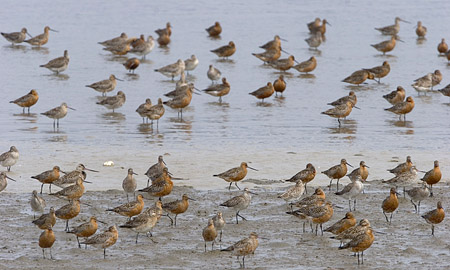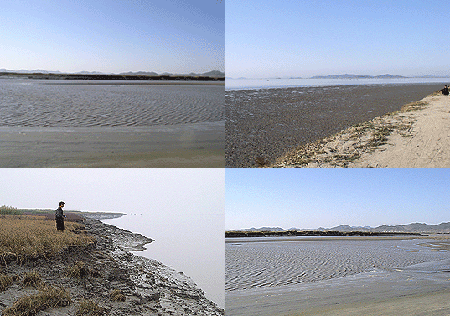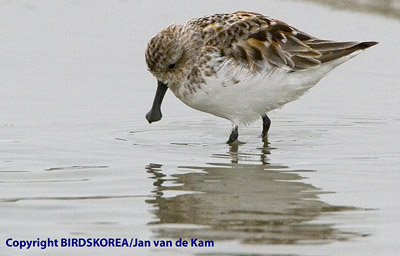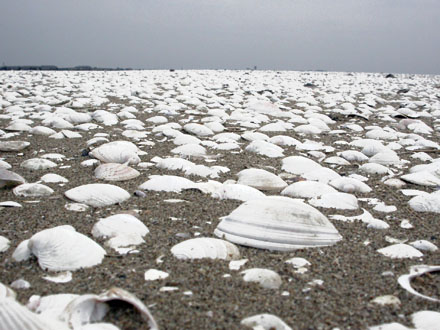
Photo © Jan van de Kam
Shorebirds have evolved very specialized migration strategies, so that the largest concentrations are found only in areas of the most extensive and productive habitat (e.g. Piersma & Baker, 2000). While some species depend on a long chain of sites during migration, other larger species (like Bar-tailed Godwit Limosa lapponica and Great Knot Calidris tenuirostris) are believed able to undertake enormous non-stop flights in spring, for example from Australia direct to Korea, before taking another huge single flight up to or near the breeding grounds. Larger species can do this because of the extraordinary productivity of the few sites that they depend on for intensive refueling (e.g Wilson & Barter, 1998), many of which on this Flyway (the East Asian-Australasian Flyway) are on South Korea's west coast.
As such, many species of shorebird can be found in spectacular concentrations on select tidal-flats in Korea during their migration. Such concentrations can be found in only a few countries globally, and at only a few sites on this Flyway.
The Yellow Sea, shared by South Korea, China and the DPRK, has an estimated 2 million ha of remaining tidal-flat (Barter, 2002), and is one of less than 10 regions globally that have “megatidal environments” (after Koh, 1997). As such the Yellow Sea is a globally very rare type of eco-system, and it forms the core staging area for an estimated 2 million migratory shorebirds in spring and a further 1 million in autumn. This represents no less than 40% of the total number of (long-range) migratory shorebirds supported by the whole East Asian-Australasian Flyway (Barter, 2002), a wide and long migration corridor stretching from southern New Zealand, through Australia, up through countries of south-east and eastern Asia, through the Yellow Sea, on through eastern Russia as far northeast as the North slope of Alaska (Wells & Mundkur, 1996).

As much of the East Asian-Australasian Flyway is comprised of habitat that is actually rather poor for shorebirds, the largest concentrations of shorebirds are found at only a very few sites, most within the Yellow Sea. Even within the Yellow Sea, only 27 internationally important sites for shorebirds had been identified by 2002, with sixteen of these in South Korea (Barter, 2002). “Saemangeum” (the estuaries of the Mangyeung and Dongjin Rivers in Jeollabuk Province) supported probably 300 000 shorebirds a year, and it was the most important known site for shorebirds not only in South Korea, but in the whole of the Yellow Sea (Barter, 2002). Following the closure of the Saemangeum seawall in April 2006, Yalu Jiang in China likely becomes the most important known shorebird site in the Yellow Sea (e.g. Woodley, 2006), and the Geum Estuary (with probably close to 100 000 shorebirds in spring 2006), South Korea's most important remaining shorebird site. This latter site, the Geum, is also threatened with either partial or complete reclamation, with permission to reclaim already granted by key government departments.
Although the Yellow Sea can be considered Asia's equivalent of the Wadden Sea of Northern Europe, supporting similarly globally important concentrations of waterbirds as well as massive fisheries, there is at least one major and highly significant difference. The Wadden Sea is a largely protected region, managed by a government-level agreement between Denmark, Germany and the Netherlands [e.g. anon, 1997]), while many of the Yellow Sea's most important shorebird sites remain unprotected, and reclamation, pollution, over-fishing and disturbance all limit shorebird numbers (Birdlife International, 2004).

Photo © Birds Korea/Jan van de Kam
Even more regrettable from a South Korean perspective, although six out of ten of the most important Yellow Sea shorebird sites in China are within Protected Areas, and the most important known DPRK site is also within a Protected Area (Barter, 2002), there are still no comprehensively protected shorebird sites along the west coast of the Republic of Korea. Rather, much of the South Korean west coast has been targeted for reclamation, including internationally important tidal-flats at Song Do, Asan and Namyang Bays, and even the Geum Estuary, meaning that wetlands, especially intertidal wetlands, remain South Korea's most threatened habitat (Moores, 2002). With an estimated 43% of South Korean tidal-flat already reclaimed by 2001 (Moores et al. 2001), with Saemangeum now lost and with the Geum Estuary threatened, it is clear that many species of shorebird in South Korea – and by extension many species on this Flyway - could have an especially bleak future.
Threats to shorebird populations are not unique to Korea or East Asia, and due to a range of factors globally 48% of shorebird species with known population trends are considered to be in decline (IWSG, 2003).

Photo © Birds Korea/Jan van de Kam
In East Asia, tidal-flat reclamation threatens the survival of many species of shorebird, including the Spoon-billed Sandpiper Eurynorynchus pygmeus, with a maximum estimate of 1706 individuals by 2005 (Syroechkovsky, 2005); the Nordmann's Greenshank Tringa guttifer (with a total global population estimated at between 500 and 1000 individuals: Li et al, in prep. 2005); and the Great Knot, a still comparatively numerous shorebird with a population of ca 380 000 individuals (Delaney and Scott, 2002), probably >95% of which are confined to this Flyway. All depend on extensive estuaries during migration. Perhaps unsurprisingly, the Saemangeum estuarine system was the single most important known staging site for all three of these species, not only in Korea but also in the Yellow Sea (Barter, 2002).
Following the closure of the sea-wall at Saemangeum in April 2006, the tidal-range within the reclamation area has been reduced from a maximum of 7 m to less than 1 m at present. Many of the tidal-flats within the enclosed area have already either become hard and dry, or have become permanently covered by water.
Forecast models reveal that 90% of the tidal-flats within the Saemangeum system will be destroyed this year, with physical changes to the substrates themselves meaning that restoration (through a hypothetical return of the original tidal regime) would likely be unsuccessful unless attempted within the next 2 or 3 years.

Photo © Nial Moores
Already, many of the shellfish beds, a vital resource for migratory shorebirds, have died, and many of the tidal-flats are now covered in dead shells. By autumn 2006, much of the 40 100 ha reclamation area will be unsuitable for the majority of species and individuals of shorebird that used to depend on this site.
An online defence of the reclamation on the Ministry of Agriculture and Forestry website (in 2003) claimed that the shorebirds displaced by the Saemangeum reclamation would simply relocate to Gomso Bay and also the Geum Estuary. However, according to research elsewhere and to the work of the Saemangeum Shorebird Monitoring Program (SSMP: a joint initiative of Birds Korea, the Australasian Wader Studies Group and numerous individuals from other groups here in the Republic of Korea), it appears that neither Gomso Bay nor the Geum Estuary have either suitable habitat or suitable area to support such huge numbers of potentially displaced birds.
In addition, during spring 2006, even several weeks after seawall completion, the SSMP failed to find unambiguous evidence of mass relocation of shorebirds from the Saemangeum reclamation area to adjacent tidal areas.
Research elsewhere suggests that many shorebirds tend to be extremely site faithful, and many species cannot adapt to new areas, even when these are close to the areas that have been lost. Those species and individuals that can eventually relocate come into increased competition with shorebirds already at the site, leading to increased mortality or lack of fitness (e.g. de Kam et al., 2004).
An ongoing study in the UK, for example, has shown that Redshanks Tringa totanus which lost their feeding site to a small tidal reclamation did indeed move to another site, but once they moved there, they experienced a 44% increase in mortality rate (Burton, 2006).

It is likely that a very large percentage of shorebirds displaced by the Saemangeum reclamation will not be able to relocate successfully and that there will be high rates of mortality in some species, due to the huge area of optimal habitat destroyed. In addition, the enormous concentrations of Great Knot in the future must now depend only on the Geum Estuary, rather than on the historical super-system that once extended almost 100 000 ha, incorporating the estuaries of the Geum, the Dongjin and the Mangyeung. Such a concentration will make increased demands on shellfish supplies there, increasing the possibility that in some years the birds will run out of food before they have put on enough weight to continue their long-distance migration. At such a time, massive numbers of birds might die or fail to migrate.
What can any of us do?
Although a small (but growing) organization, Birds Korea will continue to approach the Saemangeum reclamation and the threat to the Geum Estuary in the most effective and strategic way available to us. We will base our strategy on the SSMP; on a strategic partnership with the specialist organization Australasian Wader Studies Group (AWSG) and with other key groups and individuals where appropriate; and through the development of our own organization.
- The 2006 SSMP has already proved very successful in both gathering data and raising awareness of the impacts of this reclamation project. Several domestic newspapers carried articles based on the SSMP and interviews were also conducted with EBS TV, as well as with international media (including Reuters and AP and media in New Zealand). Preliminary data were posted on both English-language and Korean-language websites (including websites of Birds Korea; the birdwatcher's group, Korean Wild Bird Society [KWBS]; and a university student environmental network), and a joint seminar was held with several members of KWBS.
- A series of further meetings has already been initiated, both with members and non-members (including e.g. a presentation on Birds Korea and the SSMP to 35 post-graduate students in Seoul, on June 7).
- SSMP data will be processed further during June, and an interim report will be sent to participants, and posted on the Birds Korea websites. A longer report, incorporating previous data sets from surveys within the Saemangeum area and at the Geum, is also under preparation, with completion intended for late August.
- Initial discussions have also been held on a proposed symposium perhaps in late September (to be confirmed), to release/publicise the report and to invite discussion and involvement from domestic environmental groups, researchers and related specialists. Ideally, this could be supported by a photographic exhibition, and by shorebird training workshops and possibly limited autumn survey work within the Saemangeum area, and at the neighboring Gomso Bay and Geum Estuary.
- Fund-raising events will be organized, and grants applied for, to facilitate years 2 and 3 of the Program, with one aim of increasing domestic participation (and capacity) further; and a second of challenging strongly the proposed Geum Estuary reclamation. It is also hoped that the SSMP data will be fed into plans and proposals for at least partially ameliorating or mitigating the impacts of the Saemangeum reclamation, by e.g. maintaining and increasing tidal exchange within the system.The SSMP data, years 2006, 2007 and 2008, will then feed into a further National Report, which we aim to have prepared by late summer 2008, several months before South Korea hosts the Ramsar Convention. The report will aim to gather as much hard data as possible to reveal changes in wetland and wetland bird status in South Korea between 1998 and 2008. It will supplement attractive national NGO reports prepared for previous Ramsar Conventions, and be presented pre-Conference to relevant bodies, including domestic and international NGOs, and key government officials.
- In addition, early discussions with wildlife photographer Jan van De Kam have clarified the need to produce an attractive, photo-rich book detailing the life and threats to shorebirds, especially those migrating through the Yellow Sea. If funding and support can be found, such a book would also be prepared by autumn 2008, to catch the wave of domestic media interest generated by the hosting of the Ramsar Convention.
- Birds Korea is only as strong as its members and its strategic partnerships. We again thank you for your support so far, and look to provide ways for more people to involve and more people to join (especially domestically, with the aim of recruiting a further 100 paying national members by the end of 2006; a total of 400 national members by the end of 2007; and 500 by September 2008 – in addition to our international membership, now over the 400 mark); and to develop an internal structure that can allow us to fulfill the obligations and requirements of our mandate. We are still actively searching for further appropriate people to join our steering committee, and to help build semi-autonomous teams to get what needs to be done, done.
Together, let all of us, each in our own way, work towards conserving the internationally important wetlands of South Korea and the Yellow Sea, and in so doing, help to keep some of the world's most charismatic bird species away from the precipice of extinction.
References
- Anon. 1997. State Declaration. Trilateral Wadden Sea Plan. Ministerial Declaration of the Eight Trilateral Governmental Conference on the Protection of the Wadden Sea.
- Barter, M. 2002. Shorebirds of the Yellow Sea. Importance, Threats and Conservation Status. Wetlands International. Global Series 9. International Wader Studies 12, Canberra, Australia.
- Birdlife International. 2003. Saving Asia's threatened birds: a guide for government and civil society. Cambridge, UK: Birdlife International.
- Burton N., Rehfisch M., Clark N. & S. Dodd. (2006). Impacts of sudden winter habitat loss on the body condition and survival of redshank Tringa totanus. Journal of Applied Ecology 2006, 43, 464-473.
- De Kam, J., Ens B., Piersma T. & L. Zwarts. 2004. Shorebirds, An illustrated behavioral ecology. KNNV Publishers.
- Delany, S. and Scott, D. 2002. Waterfowl population estimates - Third Edition. Wetlands International Global Series No 12.
- IWSG, 2003. International Wader Study Group, Bulletin 101/102, Aug-Dec 2003.
- Koh, C-H. 1997. Korean megatidal environments and tidal power projects: Korean tidal flats – biology, ecology and land uses by reclamations and other feasibilities. La Houille Blanche/No. 3- 1997, pp. 66-78.
- Li, D. In prep. 2005. Waterbird Population Estimates, Fourth Edition, in prep. for Wetlands International.
- Moores, N., Kim S-K, Park S-B & T. Sadayoshi. 2001. Yellow Sea Ecoregion: Reconnaissance Report on Identification of Important Wetland and Marine Areas for Biodiversity. Vol 2. South Korea. WWF-Japan, Wetlands and Birds Korea, Wetlands International China Programme.
- Moores, N. 2002. Wetlands: Korea's most-threatened habitat. Oriental Bird Club bulletin No. 36, pp. 54-60.
- Piersma, T. & Baker, A.J. 2000. Life history characteristics and the conservation of migratory shorebirds. In Gosling, L.M. & Sutherland, W.J. (eds) Behaviour and Conservation: 105–124. Cambridge: Cambridge University Press.
- Syroechkovsky, E. Jr. 2005. The Spoon-billed Sandpiper on the edge: a review of breeding distribution, population estimates and plans for conservation research in Russia. Pp 169-174 in Straw, P. (Ed.) Status and conservation of shorebirds in the East Asian-Australasian Flyway: Proceedings of the Australasian Shorebirds Conference 13-15 December 2003, Canberra, Australia.
- Wetlands International Global Series No. 18; International Wader Studies No 17. Sydney, Australia
- Wells, D. and T. Mundkur. (editors). 1996. Conservation of Migratory Waterbirds and their Wetland Habitats in the East Asian-Australasian Flyway. Proceedings of an International Workshop, Kushiro, Japan, 28 Nov-3 Dec 1994. Wetlands International-Asia Pacific, Kuala Lumpur, Publication No. 116.
- Wilson, J. & M. Barter. 1998. Identification of potentially important northward migration staging area for long-jump migrant waders in the East Asian-Australasian Flyway. Stilt 32: 16-27.
- Woodley, K. 2006. Wader Survey of Yalu Jiang National Nature Reserve, 13-23 April 2006. Miranda Naturalists' Trust Newsletter, pp. 3-7.



